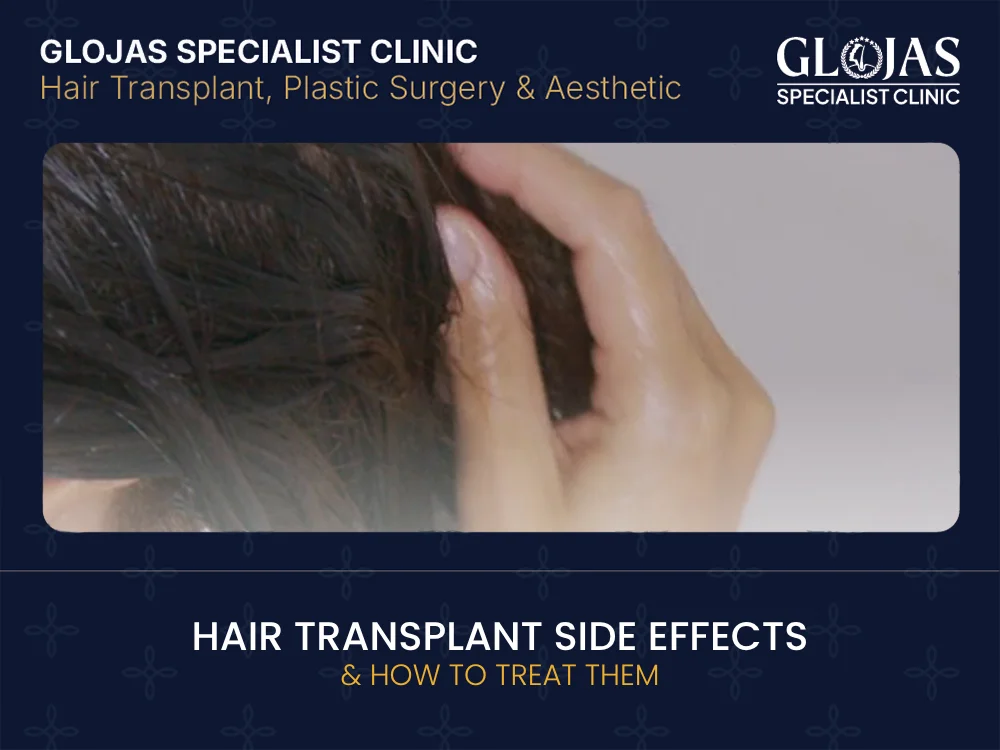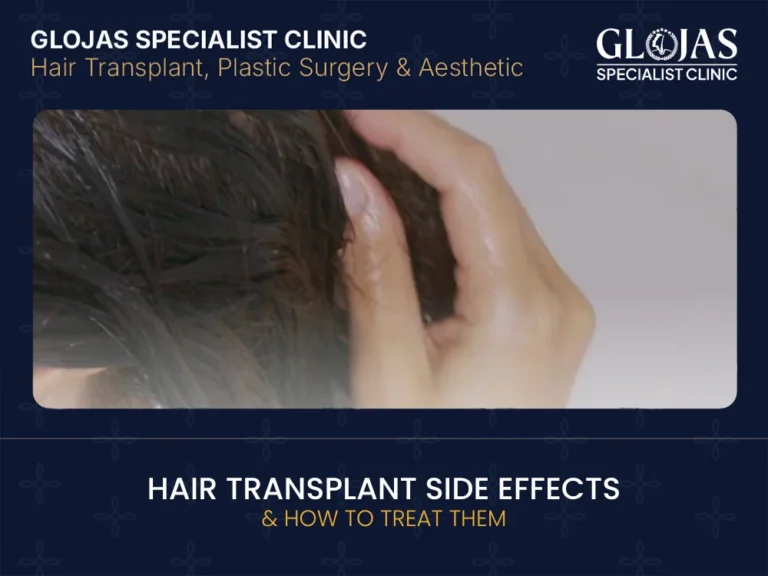When considering a hair transplant, knowing the hair transplant side effects is essential. Hair Transplant Side effects may range from mild and temporary (like swelling or itching) to rare but serious complications. In this article, we’ll walk you through the spectrum of possible reactions, what to expect, how to manage them, and when to contact your surgeon. With expert insight from ABHRS / ISHRS–certified professionals and decades of experience, you’ll be better informed and better prepared.
Common Hair Transplant Side Effects You Should Expect
Below, we cover the most frequently encountered hair transplant side effects, why they happen, and how to treat or monitor them.
1. Swelling (Edema / Oedema)
Swelling around the scalp, forehead, or even eyelids is common in the first few days.
Treatment / management:
- Sleep with your head elevated (~30–45°)
- Apply cold compresses on the forehead (not directly on grafts)
- Some clinics prescribe short courses of anti-inflammatory steroids (e.g. dexamethasone) to reduce swelling.
2. Pain, Tenderness & Discomfort
Because incisions are involved, mild pain or soreness is expected, especially in donor and recipient sites.
Treatment:
- Use prescribed analgesics or over-the-counter pain relief (as approved)
- Avoid strenuous activity or anything that stretches the scalp
- Gentle handling of scalp (no tight caps or pulling)
3. Bleeding / Oozing
Some minor bleeding or oozing of clear fluid or plasma in the first 24–48 hours is typical.
Treatment:
- Gentle pressure with sterile gauze
- Avoid rubbing or pressing repeatedly
- Contact your surgeon if bleeding persists or is heavy
4. Scabbing / Crusting
Small scabs or crusts will form around the transplanted follicles as part of the healing process.
Treatment / care:
- Do not pick or scratch scabs
- Use gentle saline sprays or surgeon-approved wash to help soften and detach scabs naturally
- Scabs typically shed by day 7–14
5. Itching / Pruritus
Itching is very common during healing, especially when scabs loosen and fall off.
How to relieve itch:
- Use sterile saline spray or moistened cotton
- Avoid scratching or rubbing
- Some clinicians may permit antihistamines if safe
6. Numbness or Altered Sensation
Temporary numbness or tingling is common, caused by nerve disruption from incisions or local anesthesia.
- This typically resolves over weeks to months
- If numbness persists long-term, discuss with your surgeon
7. Shock Loss (Shed / Shedding of Hair)
After surgery, you may experience shedding of transplanted hair (and sometimes surrounding native hair). This is a normal “shock loss” phenomenon and not failure of grafts.
- Usually around 2–3 weeks post-op
- New regrowth starts months later
8. Redness / Erythema
Skin around recipient and donor areas may appear pink to red during the early healing phase.
- This fades gradually over days to weeks
9. Folliculitis / Bumps / Pimples
Occasionally, small bumps or inflamed follicles (folliculitis) appear as grafts settle.
Treatment:
- Gentle cleaning
- Some surgeons prescribe topical or oral antibiotics if the follicles show infection
- Avoid squeezing or picking
10. Scarring / Donor Site Effects
Depending on technique (FUE, FUT, DHI), scarring is possible—linear in FUT, micro-dots in FUE.
- In rare cases, hypertrophic or keloid scars may appear
- Proper surgical technique, good post-op care, and follow-up reduce risk

Less Common but Serious Complications
While most hair transplant side effects are mild and temporary, here are rarer risks to be aware of:
- Infection / Abscess formation: If the surgical site is contaminated or aftercare is neglected, localized infection or even systemic spread has been documented.
- Scalp necrosis / tissue loss: Very rare, usually in extreme tension or vascular compromise.
- Excessive bleeding or hematoma: In unusual cases, excessive bleeding may require attention.
- Poor cosmetic results / unnatural hairline / density issues: Judgement errors or graft misplacement can lead to aesthetic dissatisfaction.
- Permanent nerve damage or persistent numbness: Rare but possible in aggressive surgery.
Always report unusual pain, spreading redness, swelling beyond expected timeline, pus, or fever to your surgeon immediately.
Treating, Managing & Minimizing Hair Transplant Side Effects
Undergoing a hair transplant or any surgical procedure on the scalp requires careful aftercare to ensure optimal results and minimal complications. While some mild hair transplant side effects—such as redness, swelling, or temporary sensitivity—are normal, they can be effectively managed and minimized through proper post-operative care. Here’s an expanded, detailed guide on what you can do (always under your surgeon’s supervision) to reduce hair transplant side effects and support smooth healing:
Follow Your Surgeon’s Aftercare Plan Diligently
Your surgeon provides a personalized aftercare plan based on your specific case, graft technique, and skin type. Strictly adhering to these instructions is the most effective way to prevent infection, ensure graft survival, and promote proper healing. This plan often includes wound care steps, timelines for washing the scalp, activity restrictions, and follow-up appointments. Deviating from this guidance can slow recovery or risk complications such as graft dislodgement or inflammation.
Use Prescribed Medications Correctly
Medications are a vital part of the recovery process. Antibiotics help prevent infection, steroids reduce swelling, and analgesics control pain and discomfort. Always take them exactly as prescribed—do not skip doses or stop early, even if you feel fine. Overusing or misusing medications may lead to delayed healing or unwanted hair transplant side effects. If you notice any adverse reaction, report it immediately to your doctor.
Maintain a Clean Yet Gentle Scalp Care Routine
Proper scalp hygiene is essential, but it must be approached with care. Avoid harsh scrubbing or pressure while washing your hair. Use only the mild, surgeon-recommended shampoo—typically a gentle, sulfate-free formula. Pat the scalp dry with a soft towel instead of rubbing. During the early days, even light friction can harm delicate grafts, so handle your scalp with extreme gentleness.
Support Healing from the Inside: Hydration, Nutrition, and Rest
Your body’s internal health plays a crucial role in external recovery. Drink plenty of water to stay hydrated and eat nutrient-rich foods high in vitamins A, C, E, and zinc to promote tissue repair and collagen production. Lean proteins help rebuild damaged tissue, while antioxidants aid in reducing inflammation. Combine this with adequate sleep—your body heals fastest when well-rested.
Avoid Smoking, Alcohol, and Blood-Thinning Substances
Nicotine constricts blood vessels, limiting oxygen and nutrient supply to healing grafts. Similarly, alcohol and blood-thinning medications (such as aspirin) can increase the risk of bleeding and slow tissue repair. Abstain from these for at least the first two weeks—or as long as your surgeon advises—to optimize healing and graft retention.
Limit Physical Exertion and Strenuous Activities
For the first week post-surgery, avoid bending over, heavy lifting, or intense exercise. Sudden increases in blood pressure can lead to bleeding, swelling, or even dislodgement of grafts. Light walking is fine and can improve circulation, but always prioritize rest and gradual activity reintroduction.
Sleep with Your Head Elevated
Keeping your head elevated—using two or more pillows or a recliner chair—helps reduce post-operative swelling. This position allows fluid to drain away from the scalp and prevents pressure on the grafted area during sleep. Try to maintain this posture for the first 3–5 nights after surgery.
Apply Cold Compresses Wisely
Cold compresses are excellent for managing forehead swelling but should never be applied directly to the grafted zones. Instead, place them gently on the upper forehead for short intervals (10–15 minutes at a time). This helps minimize puffiness and discomfort without risking damage to the new grafts.
Monitor and Document Your Healing Progress
Take clear, dated photographs of your scalp during the recovery process—especially in the first few weeks. These images help you and your surgeon track progress, detect abnormalities early, and adjust aftercare if needed. Visual documentation also provides reassurance as you observe gradual improvements over time.
Seek Prompt Medical Attention for Warning Signs
If you notice symptoms such as excessive bleeding, pus formation, increasing redness, foul odor, severe pain, or fever, contact your surgeon immediately. Early medical intervention can prevent complications and ensure successful recovery. Never attempt to self-diagnose or treat unusual symptoms with over-the-counter products or home remedies.
Timeline & When Hair Transplant Side Effects Typically Appear
Time Period | Common Side Effects | Notes / Expectations |
Day 0–3 | Bleeding, swelling, pain, redness | Intense initial phase |
Days 3–7 | Peak swelling, scabbing, redness, itchiness | Scabs begin to form |
Days 7–14 | Scabs shed, redness fades, itchiness subsides | Shock loss may begin |
Weeks 3–4 | Continued shedding, numbness recedes | Regrowth not yet visible |
Months 2–6 | Regrowth begins, side effects mostly resolved | New hair starts to appear |
Beyond 6 mo | Cosmetic refinement, long-term results | Monitor donor/recipient zones |
This aligns with published recovery maps and clinical experience.
Why Experience & Certification Matter
At GLOJAS Specialist Clinic, we combine over 25 years of expertise with certifications from ABHRS and ISHRS. We adhere to globally accepted standards in hair restoration, meticulous surgical technique, detailed patient education, and full follow-up care. That means you’re not just getting surgery — you’re getting a care ecosystem designed to reduce complications, manage hair transplant side effects properly, and support ideal results.
We know all too well how distressing hair transplant side effects can feel if unmanaged. That’s why from day one, our team guides you through side effect prevention, monitoring, and treatment, backed by decades of successful outcomes.
10 FAQs on Hair Transplant Side Effects
- Are hair transplant side effects permanent?
Most hair transplant side effects (swelling, scabs, itching, redness) are temporary and resolve within weeks or months. Only very rare complications (e.g. persistent numbness, hypertrophic scars) might linger. - When should I worry about swelling?
If swelling persists beyond 7–10 days, worsens, or spreads to eyes or cheeks unusually, consult your surgeon — may indicate infection or adverse reaction. - Is shock loss permanent?
No — transplanted hair shedding is expected. In nearly all cases, the follicles survive and regrow new hair within months. - Can I treat itching with topical creams?
Only use creams or ointments your surgeon approves. Avoid over-the-counter steroid/antibiotic products unless cleared. - When can I take a shower or wash scalp?
Follow your surgeon’s protocol, typically starting gentle washes no earlier than day 2–5, using mild products and soft technique. - Can I use minoxidil or finasteride immediately?
Not usually. Many surgeons delay these adjuncts until healing is stable (weeks to months). Discuss timing with your specialist. - How do I know if infection is present?
Signs include increasing pain, heat, redness spreading, pus, swelling after initial decline, fever. Contact your surgeon promptly. - What causes folliculitis bumps?
They can occur when grafts are settling; minor inflammation in follicles may show as small bumps. Often self-limiting, sometimes antibiotic help is given. - Will I have visible scars?
With FUE, micro-dot scars are tiny and often hidden by surrounding hair. FUT may leave a linear scar, but good technique and closure minimize visibility. - Can lifestyle affect side effects?
Yes — smoking, poor diet, alcohol, lack of rest, stress, and not following post-op instructions increase risk of complications and slower healing.
Final Thoughts
While hair transplant side effects can sound intimidating, most are mild, expected, and manageable with proper care. Being informed about what’s normal versus what signals danger is your best defense. With the right clinic, technique, and rigorous aftercare, risks are minimized and results maximized.
If you’re looking for a clinic that prioritizes not just the surgery but your recovery, GLOJAS Specialist Clinic is here for you. With over 25 years of experience and certifications from ABHRS and ISHRS, we combine artistry, science, and patient-centered care. Trust us to guide you before, during, and after your hair transplant — including side effect management for safe, beautiful results.
👉 Contact GLOJAS Specialist Clinic today for a consultation or to learn how our side effect protocols ensure smoother recovery and better outcomes.
